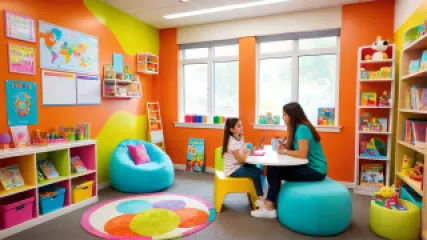Comprehensive Guide to Therapy Sessions for Learning Disabilities
Learning disabilities can pose significant challenges for individuals, affecting their ability to process information and perform everyday tasks. However, with the right support and strategies, individuals with learning disabilities can lead successful and fulfilling lives. This comprehensive guide aims to explore therapy sessions for learning disabilities, shedding light on effective strategies, professional help, and support networks that empower those affected.
Understanding Learning Disabilities
Learning disabilities are neurological disorders that affect the brain's ability to receive, process, store, and respond to information. They can impact various areas such as reading, writing, math, reasoning, listening, and speaking. Common types of learning disabilities include dyslexia, dyscalculia, dysgraphia, and auditory processing disorder.
Dyslexia
Dyslexia is a reading disorder characterized by trouble with reading despite normal intelligence. It often involves difficulties with phonological processing, spelling, and rapid visual-verbal responses.
Dyscalculia
Dyscalculia affects an individual's ability to understand numbers and learn math facts, impacting their capacity to perform arithmetic operations and grasp mathematical concepts.
Dysgraphia
Dysgraphia is a writing disability that results in distorted or incorrect handwriting, issues with spelling, and difficulty putting thoughts on paper.
Auditory Processing Disorder
Auditory Processing Disorder (APD) involves difficulty in understanding and processing auditory information, making it challenging to comprehend spoken language.
The Role of Therapy in Addressing Learning Disabilities
Therapy plays a crucial role in addressing learning disabilities by providing tailored interventions to support individuals in overcoming their challenges. Therapy sessions for learning disabilities aim to develop specific skills, enhance strengths, and implement effective strategies for learning and daily functioning.
Types of Therapy for Learning Disabilities
Various therapy approaches can be utilized to support individuals with learning disabilities. These therapies can be broadly categorized into educational therapy, speech and language therapy, occupational therapy, and psychological therapy.
- Educational Therapy: Focuses on developing academic skills through specialized teaching methods tailored to the individual's needs.
- Speech and Language Therapy: Aims to improve communication skills, including speech, language, and auditory processing abilities.
- Occupational Therapy: Helps individuals develop fine motor skills, coordination, and adaptive techniques for daily tasks.
- Psychological Therapy: Addresses emotional and behavioral aspects, providing coping strategies and building self-esteem.
Effective Strategies for Learning Disabilities
Implementing effective strategies is essential for empowering individuals with learning disabilities. These strategies can be utilized in therapy sessions, educational settings, and home environments to enhance learning and daily functioning.
Multisensory Learning
Multisensory learning involves using multiple senses simultaneously to process information. This approach engages visual, auditory, kinesthetic, and tactile senses, reinforcing learning and retention of information.
- Visual Aids: Use charts, diagrams, and color-coding to visually represent information.
- Auditory Cues: Incorporate verbal instructions, music, and rhythmic patterns to enhance auditory processing.
- Kinesthetic Activities: Engage in hands-on activities, such as writing, drawing, and manipulating objects.
- Tactile Methods: Utilize textures, shapes, and physical movements to reinforce learning concepts.
Assistive Technology
Assistive technology encompasses tools and devices designed to support individuals with learning disabilities. These technologies can aid in reading, writing, organization, and communication.
- Text-to-Speech Software: Converts written text into spoken words, aiding in reading comprehension.
- Speech Recognition Software: Transcribes spoken words into written text, assisting with writing tasks.
- Organizational Apps: Helps individuals manage schedules, tasks, and assignments effectively.
- Communication Devices: Facilitates communication for individuals with speech and language impairments.
Individualized Education Plans (IEPs)
An Individualized Education Plan (IEP) is a customized educational program designed to meet the unique needs of a student with a learning disability. IEPs outline specific goals, accommodations, and support services to facilitate the student's academic success.
Key components of an IEP include:
- Assessment and Evaluation: Comprehensive assessment to identify the student's strengths and areas of need.
- Goal Setting: Clearly defined academic and behavioral goals tailored to the student's abilities.
- Accommodations: Modifications and supports to address the student's learning challenges.
- Progress Monitoring: Regular tracking of the student's progress toward achieving IEP goals.
Professional Help for Learning Disabilities
Seeking professional help for learning disabilities is essential for obtaining accurate diagnosis, effective intervention, and ongoing support. Various professionals play a critical role in this process, including psychologists, special education teachers, speech-language pathologists, and occupational therapists.
Psychologists
Psychologists conduct assessments to diagnose learning disabilities, identify cognitive strengths and weaknesses, and recommend appropriate interventions. They also provide psychological therapy to address emotional and behavioral challenges associated with learning disabilities.
Special Education Teachers
Special education teachers are trained to work with students with learning disabilities, utilizing specialized teaching methods and strategies to support their learning needs. They collaborate with other professionals to develop and implement effective educational plans.
Speech-Language Pathologists
Speech-language pathologists assess and treat speech and language disorders, including those related to learning disabilities. They work on improving communication skills, auditory processing, and language comprehension.
Occupational Therapists
Occupational therapists focus on enhancing fine motor skills, coordination, and adaptive techniques for daily activities. They help individuals with learning disabilities develop the skills needed for academic and functional success.
Building a Learning Disabilities Support Network
A strong support network is vital for individuals with learning disabilities, providing encouragement, resources, and advocacy. This network may include family members, educators, therapists, and community organizations.
Family Support
Family members play a crucial role in supporting individuals with learning disabilities. They provide emotional support, assist with implementing strategies at home, and advocate for their loved one's needs in educational and professional settings.
Educational Support
Educators, including teachers and school counselors, offer essential academic support. They collaborate with other professionals to create inclusive learning environments and ensure that students with learning disabilities receive appropriate accommodations and interventions.
Therapeutic Support
Therapists, including psychologists, speech-language pathologists, and occupational therapists, provide specialized interventions to address specific challenges associated with learning disabilities. They work collaboratively to develop comprehensive treatment plans.
Community Resources
Community organizations, support groups, and advocacy organizations offer valuable resources and support for individuals with learning disabilities and their families. These resources may include educational materials, workshops, and peer support networks.
Empowering Individuals with Learning Disabilities
Empowerment is a critical aspect of supporting individuals with learning disabilities. By fostering self-advocacy, building self-esteem, and promoting independence, individuals can achieve their full potential.
Self-Advocacy
Self-advocacy involves individuals understanding their own needs and rights and effectively communicating them to others. Teaching self-advocacy skills empowers individuals to take charge of their learning and seek the necessary support.
Building Self-Esteem
Positive self-esteem is essential for individuals with learning disabilities to overcome challenges and pursue their goals. Encouraging strengths, celebrating achievements, and providing constructive feedback contribute to building self-confidence.
Promoting Independence
Promoting independence involves teaching individuals with learning disabilities the skills they need to manage daily tasks and make informed decisions. This includes time management, organization, and problem-solving skills.
Case Study: Empowering Success Through Therapy
Meet Natasha Mitchell, a 15-year-old student diagnosed with dyslexia. Natasha struggled with reading and writing from a young age, leading to frustration and low self-esteem. With the support of her family and a dedicated team of professionals, Natasha embarked on a journey of empowerment through therapy.
Initial Assessment and Diagnosis
Natasha's journey began with a comprehensive assessment conducted by a psychologist. The assessment identified her specific challenges and strengths, leading to a formal diagnosis of dyslexia. This diagnosis was the first step in addressing her learning needs.
Developing an Individualized Education Plan (IEP)
With the diagnosis in hand, Natasha's parents collaborated with her school to develop an IEP. The IEP outlined specific goals, accommodations, and support services to address her dyslexia. Key components included:
- Reading Interventions: Specialized reading programs that focused on phonological awareness and decoding skills.
- Writing Support: Assistive technology, such as speech-to-text software, to aid in writing tasks.
- Classroom Accommodations: Extended time for tests, access to audiobooks, and reduced reading loads.
Engaging in Therapy Sessions
Natasha participated in regular therapy sessions with a speech-language pathologist and an educational therapist. These sessions focused on developing her reading and writing skills, improving her auditory processing, and implementing multisensory learning techniques.
Speech-Language Therapy
In speech-language therapy, Natasha worked on enhancing her phonological processing and language comprehension. Activities included:
- Phonemic awareness exercises to improve sound recognition and manipulation.
- Listening and comprehension activities to strengthen auditory processing.
- Language games and storytelling to build vocabulary and narrative skills.
Educational Therapy
Educational therapy sessions focused on addressing Natasha's reading and writing challenges. Strategies included:
- Multisensory reading programs that engaged visual, auditory, and kinesthetic senses.
- Explicit instruction in decoding and encoding words.
- Writing exercises that incorporated assistive technology for transcription support.
Building a Support Network
Natasha's journey was supported by a strong network of family, educators, and therapists. Her family provided encouragement and implemented strategies at home, while her teachers offered classroom accommodations and additional support. Regular meetings ensured that everyone was aligned on her progress and goals.
Conclusion: Achieving Success Through Therapy
Natasha's story is a testament to the power of therapy sessions for learning disabilities. With the right interventions, support, and empowerment, individuals with learning disabilities can achieve remarkable success. This comprehensive guide highlights the importance of addressing learning disabilities through professional help, effective strategies, and a robust support network.
By understanding the unique needs of individuals with learning disabilities and providing tailored interventions, we can create an inclusive environment where everyone has the opportunity to thrive. Whether through therapy sessions, educational plans, or community resources, the journey towards empowerment and success is a collaborative effort that makes a profound difference in the lives of those affected by learning disabilities.
In summary, therapy sessions for learning disabilities are a cornerstone of effective intervention and empowerment. From understanding the various types of learning disabilities to implementing strategies and building support networks, this guide provides a comprehensive overview of the steps needed to address learning disabilities. By embracing these approaches, we can foster an environment where individuals with learning disabilities can reach their full potential and lead fulfilling lives.






